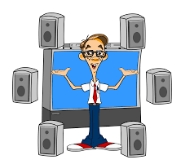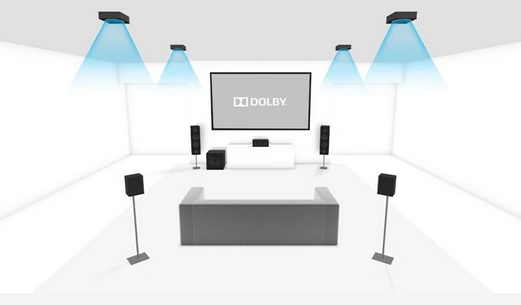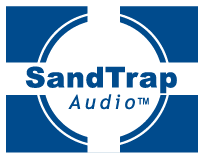Ed's AV
Handbook
Batting Bractice for the AV Professional
and primer for the novice
Chapter 1 Page 3
AV Terminology
Surround Sound
A friend commented that he appreciated the surround sound
descriptions and speaker layouts outlined below. But he
still did not clearly understand surround sound. And he
asked, why are there so many format acronyms? My attempt
at explanation began with the use of stereo audio in a movie
theater.
Stereo audio can be effective if a viewer sits in a theater
seat near or beyond the stereo sweet spot location. If
they sat closer plus well left or right of the sweet spot as
they viewed an actor screen center,
they heard their voice
emanating from
the edge of the screen. This can be
disorienting.
Dolby Labs popularized a solution, a surround sound format
that radiates the sound of screen images from their screen
location. They direct the sound of screen-left images to
a left-placed speaker, screen-right images to a right speaker,
and centered-images to a center speaker. Plus, as the
name implies, they installed rear channel speakers that allow
for surrounding enveloping effects. Star-ships fly front
to back, left to right, diagonally, and circularly around the
theater. The addition of a dedicated low-frequency
effects channel rocks theater audiences with exploding
concussive sound.
Home Theater Surround Sound Formats
Analog Dolby Surround
Analog Dolby Surround is the
original home surround sound format. Some may recall SQ
and QS quadraphonic LP records. They concealed rear
channels within a stereo recording. Analog Dolby
Surround uses a similar method.
The original Dolby Surround home sources include the HiFi Beta
videotape, the HiFi VHS videotape, and the LaserDisc.
Analog Dolby surround sound was available in two versions,
Dolby Surround and Dolby Pro Logic.
Dolby Surround routes stereo audio through a circuit that takes the difference between the left and right stereo channels. Dolby routes the difference, a monaural and low-frequency limited (almost no bass) channel, to a left and a right rear placed speaker. The circuit does not affect the reproduction of the front left/right stereo audio.
Dolby Pro Logic adds the movie theater center channel, the sub-woofer channel, and modifies the left and right front channels to set the left/right audio edges of the image. The rear-channel is as Dolby Surround. The following details the logic used to create Pro Logic Surround Sound via a Dolby Labs integrated chip.
= (left channel - right channel)
Center
= [(left channel + right channel) - (rear channel)]
Left Edge
= (left channel - center channel)
Right Edge
= (right channel - center channel)
Sub-woofer
= low pass filtered (left channel + right channel)


Digital Dolby and DTS Surround Sound.
Digital Surround Sound eliminates
difference matrix processing. Each audio channel is
recorded as a discrete channel and routed to a dedicated
speaker.
The DVD, the BluRay disc, and Internet streaming employ the
Dolby and DTS digital formats. Broadcast satellite,
cable, off-air ATSC, and soon ATSC 3.0 NextGen TV use Dolby
formats. Dolby Digital and DTS are available in the
following versions.
Dolby Digital
Dolby Digital 5.1
Dolby Digital 5.1 consists of five discrete full range audio
channels (front left/center/right, rear left/right) plus the
'point 1' low-frequency effects sub woofer channel.
Let me emphasize that all of the five main channels are full
range - 20Hz to 20Khz - audio. Large rear
speakers can reproduce exciting low-frequency bass effects
that small rear speakers cannot.
Dolby Digital EX 6.1 & 7.1
Dolby 6.1 and 7.1 provide more rear fill in a larger room.
Dolby 6.1 provides a 6th discrete, or matrix-derived from a
5.1 mix, center rear channel.
Dolby 7.1 duplicates the 6.1 rear center channel and routes it
to another rear placed seventh speaker.
Dolby Pro Logic II
Pro Logic II creates 5.1 surround sound from stereo movie
soundtracks.
Dolby Pro Logic IIx
Pro Logic IIx adds a center-rear channel to Pro Logic II
derived from stereo movie soundtracks.
DTS
DTS employs the same layouts as Dolby. The difference -- Dolby protects small home theater center speakers by limiting center channel dynamics with the complementary limiting of the front left and right channels. DTS does not. Therefore, DTS has the potential to generate more dynamic playback. Also, many point out that Dolby compresses 5.1 digital audio to 640kbit/sec, while DTS supports a higher bit rate of 1.5Mb/sec. Higher bit rate may extend the DTS advantage.
EX 6.1 and 7.1 offer the same additional rear center channel arrangements as Dolby Digital.



Multi-channel and the Blu-ray Disc
Blu-ray offers the Dolby HD & DTS HD Master Audio lossless surround sound formats,Blu-ray also offers the Dolby Digital Plus and the DTS HD lossy surround formats.
And each requires version HDMI 1.3 or higher.
Immersive surround from above
The Atmos process works via an 'object-oriented' effect. Digital 'tags' are assigned to film objects in the sound mix directed to specific speakers.
2015 DTS:X introduced the object-oriented tags and above channels.
Ed's AV Handbook
Copyright 2007 Txu1-598-288 Revised 2024
Site Menu
Home
Table of
Contents
Handbook Chapters
1 AV
Terms
2 AV Physics
3 Sound Reproduction
4 Video Reproduction
5 The AV System Sequence
6 The Room, Speaker, & TV
7 Acoustical Strategy - Small Room
8 Home Theater by Design
9 AV Sales Training
10 AV Business & Marketing
Contact
About



